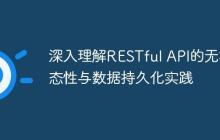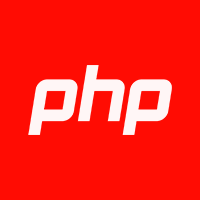-

- SOAP与消息中间件?ActiveMQ集成示例?
- SOAP与消息中间件结合,可实现异步解耦和可靠传输。通过将SOAP消息作为有效载荷封装进ActiveMQ的JMS消息中,系统能在高并发下实现削峰填谷、提升容错能力。发送方将SOAP请求序列化后发送至队列,接收方异步消费并处理,再通过响应队列返回结果。该模式适用于对实时性要求不高但需高可靠性的场景,如订单处理。SpringBoot集成ActiveMQ时,使用JAXB进行XML绑定,JmsTemplate发送消息,@JmsListener接收消息,实现SOAPoverJMS的轻量级异步通信。尽管增加
- 后端开发 . spring-boot 699 2025-08-27 13:12:02
-

- 深入理解RESTful API的无状态性与数据持久化实践
- 本教程深入探讨RESTfulAPI的无状态性核心原则,阐明为何不应在服务器内存中维护跨API调用的数据状态。我们将详细介绍RESTful架构的无状态约束,分析在服务器端存储会话或资源状态的弊端,并推荐使用数据库等外部持久化机制来可靠地管理数据,确保API的可伸缩性、可靠性和一致性。
- 后端开发 . spring-boot 853 2025-08-26 18:18:14
-

- Spring Batch 应用监控方案详解
- 本文旨在介绍SpringBatch应用的监控方案,重点讲解如何利用Micrometer集成Prometheus和Grafana实现全面的性能指标监控。内容涵盖SpringBatch监控的标准方式、Micrometer的集成方法以及相关文档和示例,帮助开发者快速搭建高效的监控体系,从而及时发现并解决性能瓶颈。
- 后端开发 . spring-boot 152 2025-08-26 17:32:23
-

- Spring Batch 应用性能监控:基于 Micrometer 的标准实践
- 本文详细阐述了SpringBatch应用性能监控的标准方法,核心是利用Micrometer及其与SpringBatchv4.2+的原生集成,以获取批处理任务的关键指标。同时,结合SpringActuator监控JVM层面数据,并通过与Prometheus、Grafana等APM工具的集成,实现全面的性能洞察,包括任务执行时间、瓶颈识别以及与外部系统交互的延迟分析。
- 后端开发 . spring-boot 708 2025-08-26 17:30:12
-

- spring boot 核心配置文件是什么?
- SpringBoot的核心配置文件是application.properties和application.yml,前者使用键值对,后者采用YAML格式,通过缩进表示层级,更易读且适合复杂配置;YAML优先级高于properties,二者可共存但建议只用一种;通过Profile实现多环境管理,如application-dev.yml等,并可通过命令行、环境变量等方式激活;配置加载顺序从高到低依次为:命令行参数、系统属性、环境变量、Profile配置、默认配置文件等,实现灵活的外部化配置。
- 后端开发 . spring-boot 258 2025-08-26 08:04:01
-

- Thymeleaf教程:利用URL参数在页面间传递表格行数据
- 本文将详细介绍在Thymeleaf应用中,如何实现在点击表格行中的“申请”按钮时,将该行特定数据(如课程编号)安全有效地传递到目标页面。通过利用Thymeleaf的标准URL语法,我们将数据作为查询参数嵌入到链接中,从而实现页面间的数据传递,确保用户体验的连贯性。
- 后端开发 . spring-boot 326 2025-08-25 16:38:12
-

- Spring Security 中缓存 Introspect 请求
- 本文档介绍了如何在SpringSecurityOAuth2资源服务器中缓存OpaqueTokenIntrospection请求,以提高系统在认证服务器不稳定时的可用性和性能。通过自定义OpaqueTokenIntrospector并集成缓存机制,可以有效减少对认证服务器的依赖,避免频繁的401错误,提升用户体验。
- 后端开发 . spring-boot 950 2025-08-24 19:12:02
-

- 使用 Spring JdbcTemplate 类访问 DynamoDB 的方法
- 本文将探讨如何利用Spring生态系统中的JdbcTemplate类,以及如何将其概念应用于NoSQL数据库DynamoDB。虽然JdbcTemplate并非直接为DynamoDB设计,但我们可以借鉴其设计思想,通过Spring提供的其他工具和库,实现类似的数据访问和流式处理功能。本文将介绍如何构建一个基于DynamoDB的数据访问层,并提供相应的代码示例和注意事项。
- 后端开发 . spring-boot 428 2025-08-24 16:58:01
-

- Gradle多模块项目依赖配置详解与常见错误规避
- 本文深入探讨了Gradle多模块项目中的依赖配置,特别是子项目间依赖的正确声明方式。我们将重点分析在多模块结构中,子项目无法识别其他子项目依赖的常见错误原因,并提供详细的settings.gradle和build.gradle配置示例,旨在帮助开发者构建结构清晰、依赖明确的Gradle多模块应用,避免因配置不当导致的构建失败。
- 后端开发 . spring-boot 859 2025-08-24 16:04:10
-

- Gradle多模块项目依赖配置指南:解决子项目间依赖找不到的问题
- 本文深入探讨了Gradle多模块项目配置中子项目间依赖无法解析的常见问题。通过详细解析错误的根源——子项目拥有独立的settings.gradle文件,并提供了正确的Gradle多模块项目结构和配置示例,旨在帮助开发者构建清晰、可维护的复杂项目,确保项目间依赖的正确识别与管理。
- 后端开发 . spring-boot 932 2025-08-24 15:56:21
-

- Gradle多模块项目依赖配置:解决子项目无法识别的常见问题
- 本教程深入探讨Gradle多模块项目构建中,子项目间依赖配置的常见陷阱及解决方案。重点阐述了根settings.gradle文件的核心作用,纠正了子项目内不当的settings.gradle配置,并提供了正确的项目结构和build.gradle依赖声明范例,确保项目能够顺利解析内部依赖,实现模块化开发。
- 后端开发 . spring-boot 614 2025-08-24 15:34:22
-

- MySQL如何快速修改root密码?MySQL更新root权限的5种高效方法
- 修改MySQL的root密码有多种方法,具体选择取决于是否记得旧密码及MySQL服务状态。若记得密码,可使用mysqladmin命令或登录后执行ALTERUSER、SETPASSWORD语句修改;若忘记密码,则需通过--skip-grant-tables模式启动MySQL跳过权限验证,或使用--init-file指定初始化脚本重置密码。重置后必须正常重启服务以恢复权限检查。修改密码后,需同步更新应用程序配置并重启服务,避免因连接池缓存导致连接失败。同时应确保root用户仅限本地访问,使用强密码并
- 后端开发 . spring-boot 693 2025-08-24 08:02:01
-

- Spring Boot 中 Logback 日志输出对齐实践
- 本文将深入探讨如何在SpringBoot应用中,通过配置Logback日志框架,实现SLF4J日志输出的精确对齐。核心在于理解SLF4J作为日志门面与Logback作为具体实现的分离,并利用Logback强大的模式格式化功能,特别是宽度和对齐修饰符,来优化日志的可读性,确保如类名与分隔符等关键元素的整齐排列。
- 后端开发 . spring-boot 786 2025-08-23 22:44:36
-

- 对齐 SLF4J 日志输出的教程
- 本文旨在帮助开发者在使用SLF4J(SimpleLoggingFacadeforJava)时,通过配置底层日志框架(例如Logback)来实现日志输出的对齐效果。SLF4J仅是一个日志门面,实际的日志格式控制由其底层的日志实现来完成。本文将重点介绍如何利用Logback的格式化选项,包括填充和最小/最大宽度设置,来实现日志信息的对齐显示,从而提高日志的可读性。
- 后端开发 . spring-boot 416 2025-08-23 22:28:00
-

- SLF4J日志输出对齐:Logback模式修饰符深度解析
- SLF4J作为Java日志门面,其日志输出格式并非由自身控制,而是依赖于底层的日志实现框架。在SpringBoot应用中,默认采用Logback。本文将深入探讨Logback的模式修饰符,特别是宽度和填充选项,指导开发者如何精确控制日志输出格式,实现诸如分隔符对齐等需求,提升日志可读性。
- 后端开发 . spring-boot 529 2025-08-23 22:22:30

PHP讨论组
组员:3305人话题:1500
PHP一种被广泛应用的开放源代码的多用途脚本语言,和其他技术相比,php本身开源免费; 可以将程序嵌入于HTML中去执行, 执行效率比完全生成htmL标记的CGI要高许多,它运行在服务器端,消耗的系统资源相当少,具有跨平台强、效率高的特性,而且php支持几乎所有流行的数据库以及操作系统,最重要的是





























